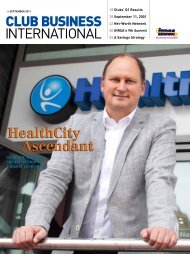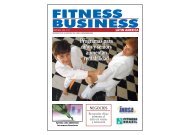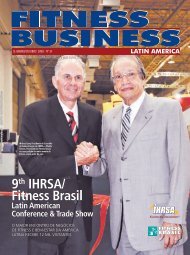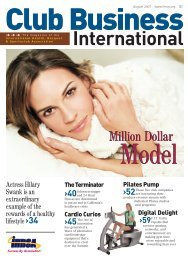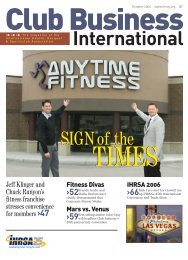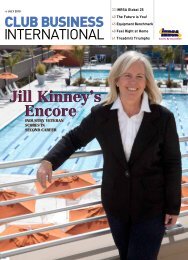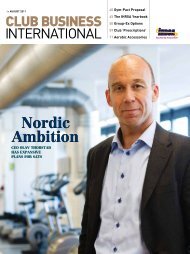Augie In Action! Augie In Action! - Ihrsa
Augie In Action! Augie In Action! - Ihrsa
Augie In Action! Augie In Action! - Ihrsa
You also want an ePaper? Increase the reach of your titles
YUMPU automatically turns print PDFs into web optimized ePapers that Google loves.
Mean Percent Change<br />
Total revenue: $1.64 million 5.2%<br />
Total membership/dues revenue: $1.09 million 4.0%<br />
Total non-dues revenue: $0.54 million 7.8%<br />
Same-store total revenue: $1.73 million 5.3%<br />
Same-store membership/dues revenue: $1.14 million 4.4%<br />
Same-store non-dues revenue: $0.59 million 6.9%<br />
Total membership accounts: 3,073 -1.5%<br />
Same-store total membership accounts: 3,067 0.4%<br />
EBITDAR $0.47 million 5.3%<br />
Note: Data reflects information from 18 leading U.S. health and sport club companies, representing<br />
194 facilities. Same-store revenue data reflects clubs that have been in operation for at least two<br />
years. Participating companies reported owning/managing an average of 11 facilities (same-store<br />
count average of 8 facilities). EBITDAR: Earnings before interest, taxes, depreciation, amortization,<br />
and rent.<br />
| News & Know How | News<br />
IHRSA Clubs Report Strong<br />
Third Quarter 24 Hour Fitness<br />
Arecent IHRSA survey of<br />
18 leading U.S. health and<br />
sports club companies revealed<br />
that commercial clubs’ financial<br />
performance improved significantly<br />
for the third quarter of 2007 (which<br />
ended September 30), compared<br />
with the same period in 2006.<br />
These mid-sized companies, representing a total of 194 facilities,<br />
grew their total revenue by an average of 18.1%, to $16.6 million,<br />
according to the survey, which was conducted for IHRSA by <strong>In</strong>dustry<br />
<strong>In</strong>sights, <strong>In</strong>c. The participating companies also reported improved<br />
same-store revenue—by an average of 5.4%, to $7 million—for clubs<br />
that have been in operation for at least two years.<br />
On a per-club basis, individual units increased their revenue by an<br />
average of 5.2%, to $1.6 million. Nearly 70% of the total revenue was<br />
fueled by membership dues revenue, which totaled $1.1 million and<br />
grew 4% since the third quarter of 2006.<br />
“We’re pleased to report that these leading health clubs consistently<br />
grew dues and nondues revenue, while holding gross margins at 29%<br />
for the third quarter,” notes Joe Moore, IHRSA’s president and CEO.<br />
Looking forward, Katie Rollauer, the association’s senior manager<br />
of research, observes, “This growth pattern has been evident during<br />
all three quarters in 2007, and we anticipate a positive outlook for the<br />
year-end due to a historical increase in membership sales that typically<br />
occurs late in the fourth quarter.”<br />
The survey also found that the average earnings before interest,<br />
taxes, depreciation, amortization, and rent (EBITDAR) improved by<br />
5.3%, to $470,000. As a percentage of total revenue, EBITDAR was<br />
29% of revenue. —|<br />
3RD QUARTER 2007<br />
(FROM Q3-2006 TO Q3-2007 PER CLUB ANALYSIS)<br />
Makes ‘Strategic<br />
Adjustments’<br />
Five executives, including<br />
founder, leave the company<br />
> <strong>In</strong> January, Mark Mastrov, the founder of<br />
24 Hour Fitness Worldwide, <strong>In</strong>c., resigned as the<br />
chairman of the San Ramon, California-based<br />
chain, the first step in a major management<br />
realignment. Then, on the last day of the<br />
month, the official date of Mastrov’s departure,<br />
the company announced that four other<br />
executives were leaving. They are: Tony Bakos,<br />
vice president and general counsel; Mike<br />
Feinman, vice president; Don Harbich, vice<br />
president; and Adam Loew, vice president<br />
of new club development.<br />
<strong>In</strong> a statement about the latter changes, the<br />
company said: “24 Hour Fitness is dedicated to<br />
growing our business and to providing worldclass<br />
service to our customers. As part of this<br />
ongoing commitment, we regularly evaluate<br />
our resources and organizational structure<br />
and make strategic adjustments where<br />
necessary. Our recent personnel changes<br />
are consistent with these objectives… ”<br />
Earlier, the company had explained,<br />
simply, that Mastrov was leaving to “pursue<br />
other interests.”<br />
24 Hour Fitness, started by Mastrov in<br />
1983, now has more than 400 clubs and<br />
3 million members worldwide. <strong>In</strong> 2005, the<br />
company was sold to Forstmann Little<br />
and Co., a private investment firm, for<br />
$1.6 billion, and, the following year, Mastrov<br />
ceded his CEO position to Carl C. Liebert III,<br />
a former executive at The Home Depot.<br />
What Feinman would be doing in the<br />
future soon became clear: Last month,<br />
Gold’s Gym <strong>In</strong>ternational, <strong>In</strong>c. (GGI),<br />
announced that it had hired him to serve<br />
as its chief operating officer (COO), with<br />
responsibility for its 62 corporate-owned<br />
facilities. “We’ve known Mike for several<br />
years now and are excited to have him on<br />
board,” says David Schnabel, the CEO of<br />
GGI. “We’ve admired his accomplishments<br />
from afar, and look forward to having his<br />
expertise in-house.” —|<br />
www.ihrsa.org | MARCH 2008 | Club Business <strong>In</strong>ternational 39



